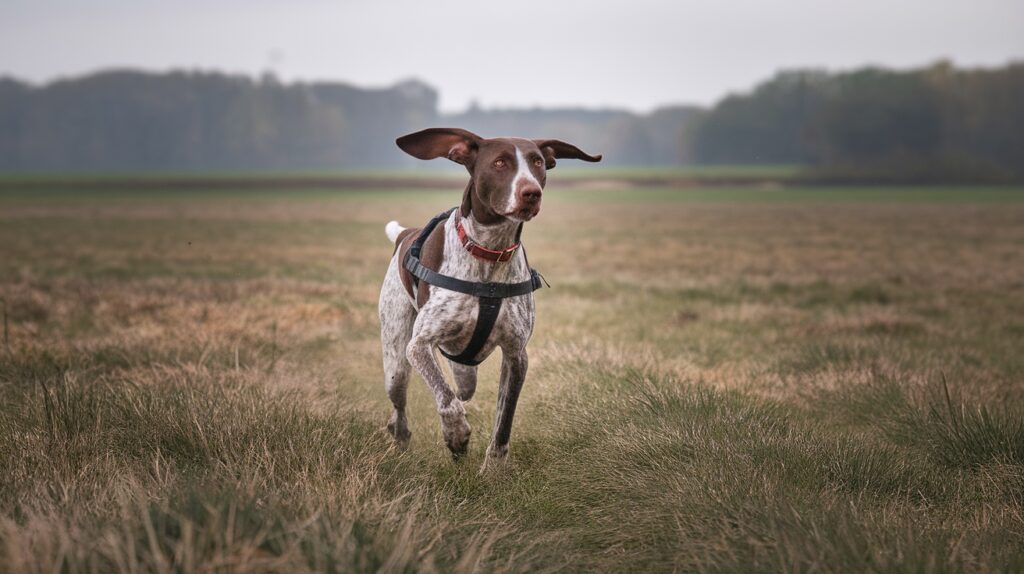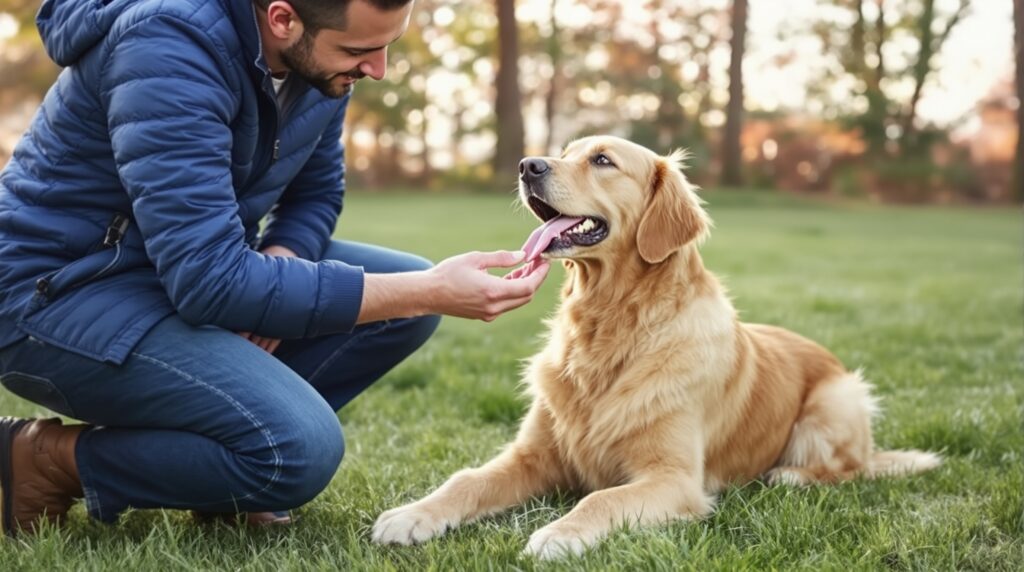Australian Shepherds love to stay busy. They really thrive when you give them tasks that challenge both their minds and bodies.
These dogs were bred to work. Regular exercise alone often isn’t enough to keep them satisfied.
The best way to keep an Aussie happy is by giving them training jobs that provide structure, purpose, and stimulation.
With the right activities, Aussies can channel their energy into positive outlets. Training jobs keep them active and strengthen the bond they share with their families.
Let’s look at different ways to turn training into enjoyable “jobs” that fit their natural drive and intelligence.
Agility Training Courses
Agility training gives Australian Shepherds both mental and physical exercise. These courses use obstacles like jumps, tunnels, and weave poles that challenge the dog’s focus and coordination.
Most trainers recommend waiting until the dog is at least one year old before starting full agility work. That helps protect their joints and ensures they’re strong enough for the activity.
Beginning with basic obedience makes the transition easier. Skills such as sit, stay, and recall help the dog listen and follow directions on the course.
Positive reinforcement, like treats or praise, keeps the dog motivated. Short, consistent sessions work better than long ones, as Aussies learn quickly but lose focus if pushed too hard.
Local training centers often offer structured classes. These provide safe equipment, professional guidance, and a chance for socialization with other dogs.
For owners who like to practice at home, small starter equipment like low jumps or tunnels can help. Gradually increasing the difficulty keeps the dog engaged without overwhelming them.
Herding Practice Sessions
Australian Shepherds were bred to herd, so practice sessions let them use their natural skills. Even without livestock, owners can set up simple activities that mimic herding.
Some people use small groups of animals like ducks or sheep if they have the space and resources. Others create herding games using balls or cones to guide and control.
These activities help the dog learn commands while moving with purpose. Short, regular sessions work better than long, tiring ones.
The dog stays motivated and avoids frustration. Consistent practice also strengthens the bond between the dog and owner.
Herding practice teaches self-control, listening, and problem-solving. When guided well, these sessions provide both mental and physical challenges that fit the breed’s instincts.
Toy Retrieval Challenges
Toy retrieval challenges give an Australian Shepherd a simple job that uses both body and mind. They enjoy the chance to chase, grab, and return items, which taps into their natural drive to stay active.
Owners can make the game more interesting by changing the type of toy used. A ball, rope, or soft toy each offers a different feel and weight, keeping the dog curious.
Adding small obstacles, like hiding the toy behind a chair or in tall grass, encourages problem-solving. The dog learns to think through the task instead of just running in a straight line.
Some dogs may need extra practice with returning the toy. Using short sessions and clear praise helps them understand that bringing the toy back is part of the job.
Rotating toys or hiding them in new spots prevents the game from becoming boring. This variety keeps the dog excited to play and builds stronger focus during training.
Obstacle Course Runs
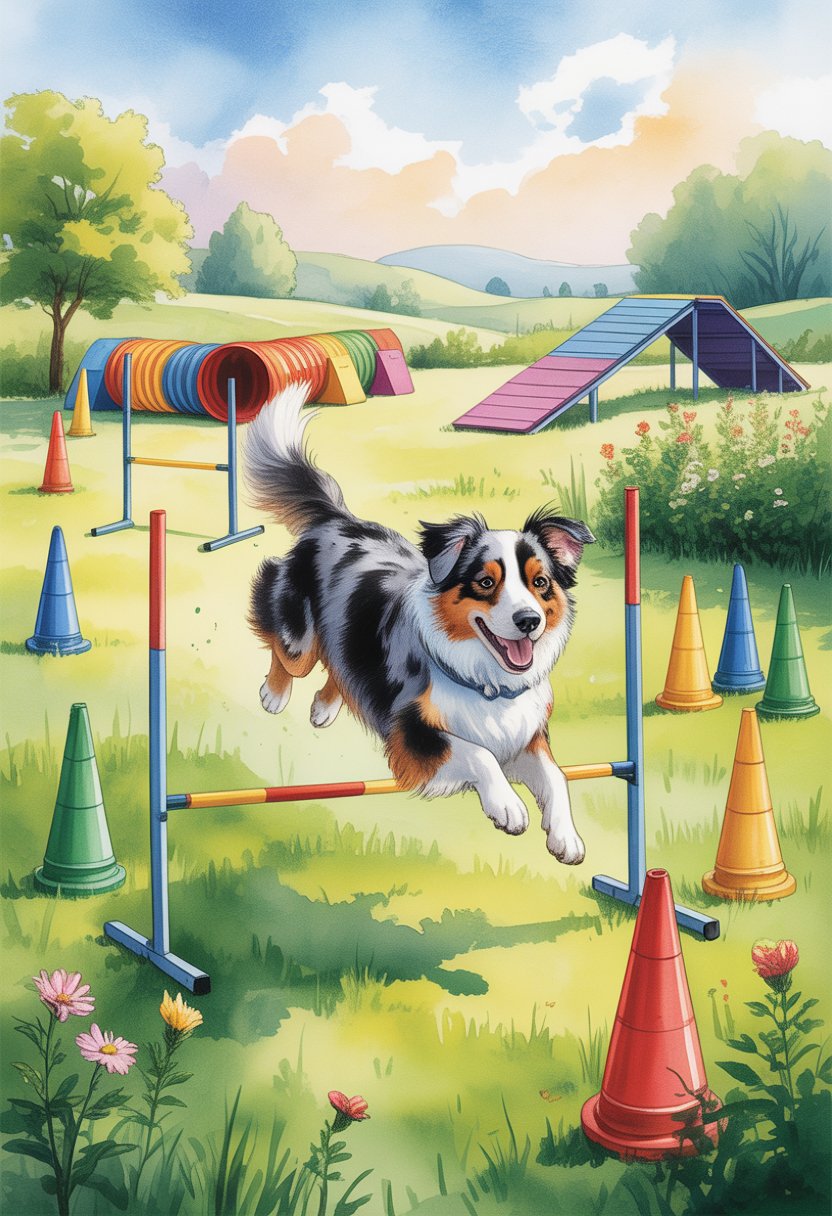
An obstacle course gives an Australian Shepherd both physical exercise and mental focus. They enjoy moving through tunnels, weaving around poles, and jumping over low bars.
Each challenge keeps their body active and their mind sharp. Owners can set up a simple course in the yard with cones, boxes, or small hurdles.
Even a few household items can create fun paths for a dog to follow. The variety helps prevent boredom and keeps training interesting.
Running courses strengthens the bond between dog and owner. The dog learns to listen for cues and follow directions while staying engaged.
Agility training centers often provide structured courses with proper equipment. These spaces let the dog practice safely and improve skills over time.
Short runs on a course give an Australian Shepherd a job that matches their high energy. It channels their need to work into a safe, fun, and structured task.
Search and Rescue Drills

Search and rescue drills give Australian Shepherds a chance to use their sharp noses and quick thinking. These activities let them practice finding hidden objects or people, which taps into their problem-solving skills.
Owners can start small by hiding treats or toys around the house or yard. The dog learns to use scent and memory to track down the item.
As the dog improves, the drills can move to larger spaces with more distractions. Parks, fields, or wooded areas provide new challenges that keep the training fresh.
Some families connect with local search and rescue groups for more structured training. This helps the dog learn teamwork, patience, and discipline.
Even if the dog never works in real rescue missions, these drills are still rewarding. They give the Australian Shepherd a job to do, which helps manage its high energy and need for purpose.
Obedience Training Routines
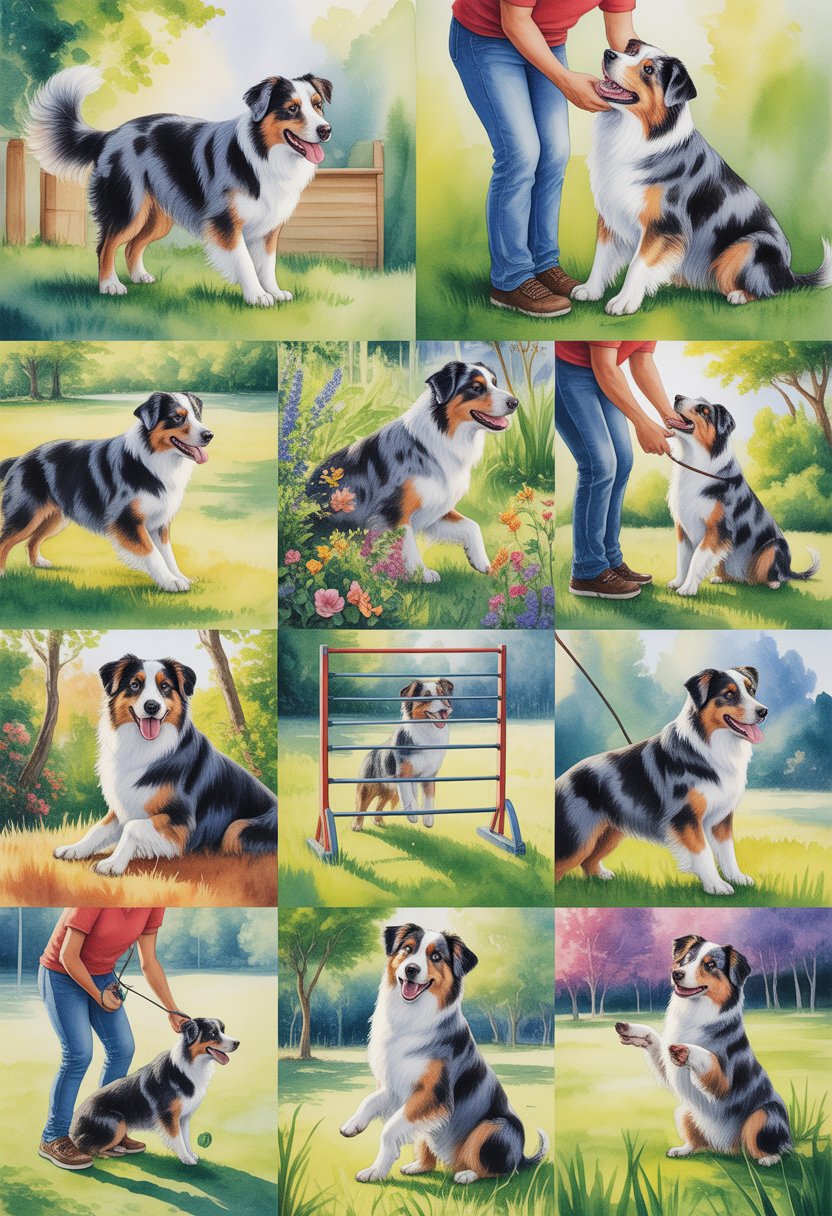
Obedience training helps Australian Shepherds learn structure and clear expectations. These dogs are smart and energetic, so regular practice keeps their minds busy.
Short daily sessions work best. Ten to fifteen minutes of focused training prevents boredom and helps the dog stay engaged.
Starting in a quiet space with few distractions makes it easier for them to succeed. Basic commands like sit, stay, come, and heel form the foundation.
Once they respond well, owners can add more advanced commands or practice from a distance. Consistency matters.
Using the same words, gestures, and rules avoids confusion and helps the dog understand what’s expected. Positive reinforcement, such as treats, praise, or play, encourages the dog to repeat good behavior.
Therapy Dog Visits
Therapy dog visits give Australian Shepherds a chance to use their friendly nature in a positive way. They can bring comfort and companionship to people in hospitals, schools, or care centers.
An Aussie enjoys the attention and interaction that comes with these visits. The training process also strengthens the bond between the dog and its handler.
These visits require calm behavior, good manners, and patience. With practice, an Australian Shepherd can learn to stay relaxed in new places and around different people.
Therapy work provides mental stimulation. The dog gets to focus on tasks, follow cues, and engage with people in a structured setting.
Many Aussies thrive in this role because they’re intelligent, social, and eager to please. It gives them a meaningful job while helping others at the same time.
Puzzle Feeder Games
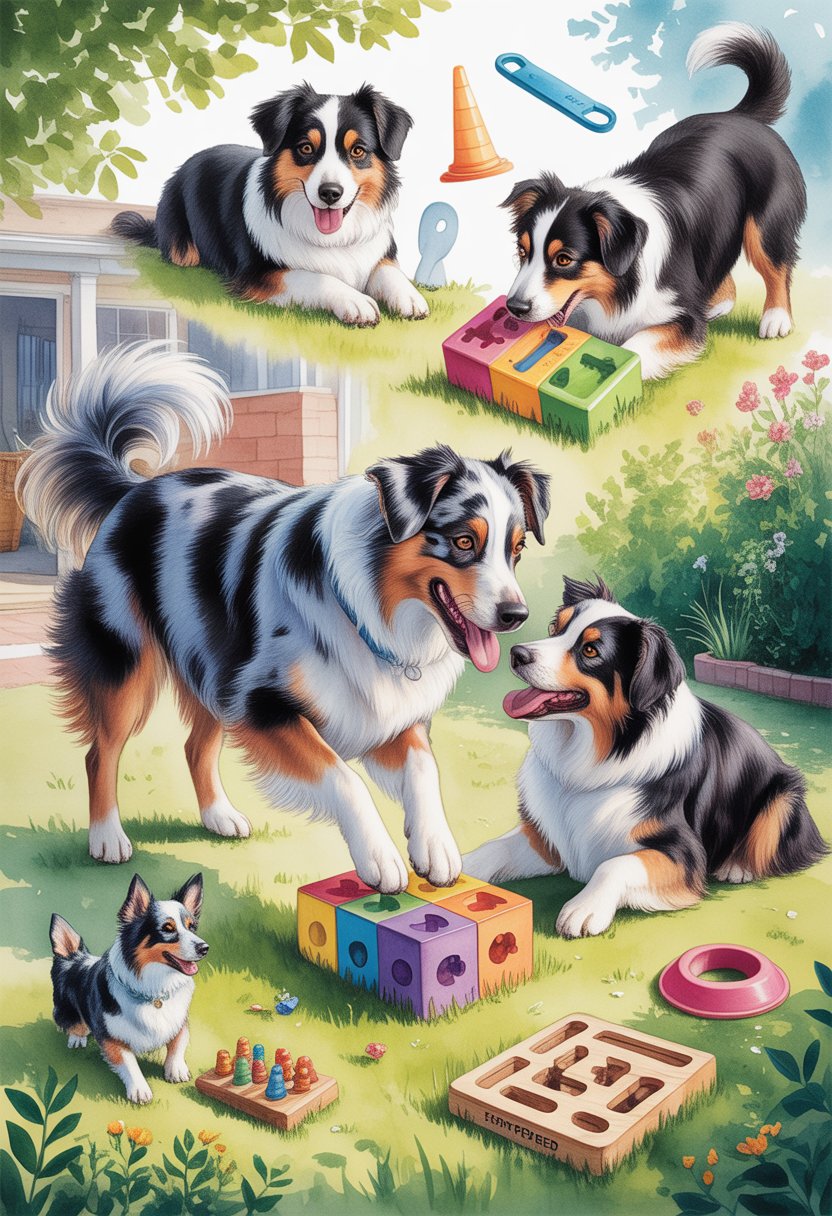
Puzzle feeders give Australian Shepherds a chance to work for their food. Instead of eating from a plain bowl, they need to solve small challenges to reach their meal.
This keeps their minds active and slows down fast eaters. These games come in many forms, such as treat-dispensing balls or sliding puzzles.
Each design encourages problem-solving, which matches well with the breed’s natural intelligence. Owners can start with simple feeders and move to harder ones as their dog learns.
Using a puzzle feeder can help during times when the dog is alone. The activity keeps them busy and reduces boredom, which may lower the chance of unwanted chewing or digging.
Many dogs enjoy the reward of finding food after effort. For an Australian Shepherd, this type of job feels like a task with a clear goal, which makes it more satisfying than a standard meal.
Trick Training Sessions
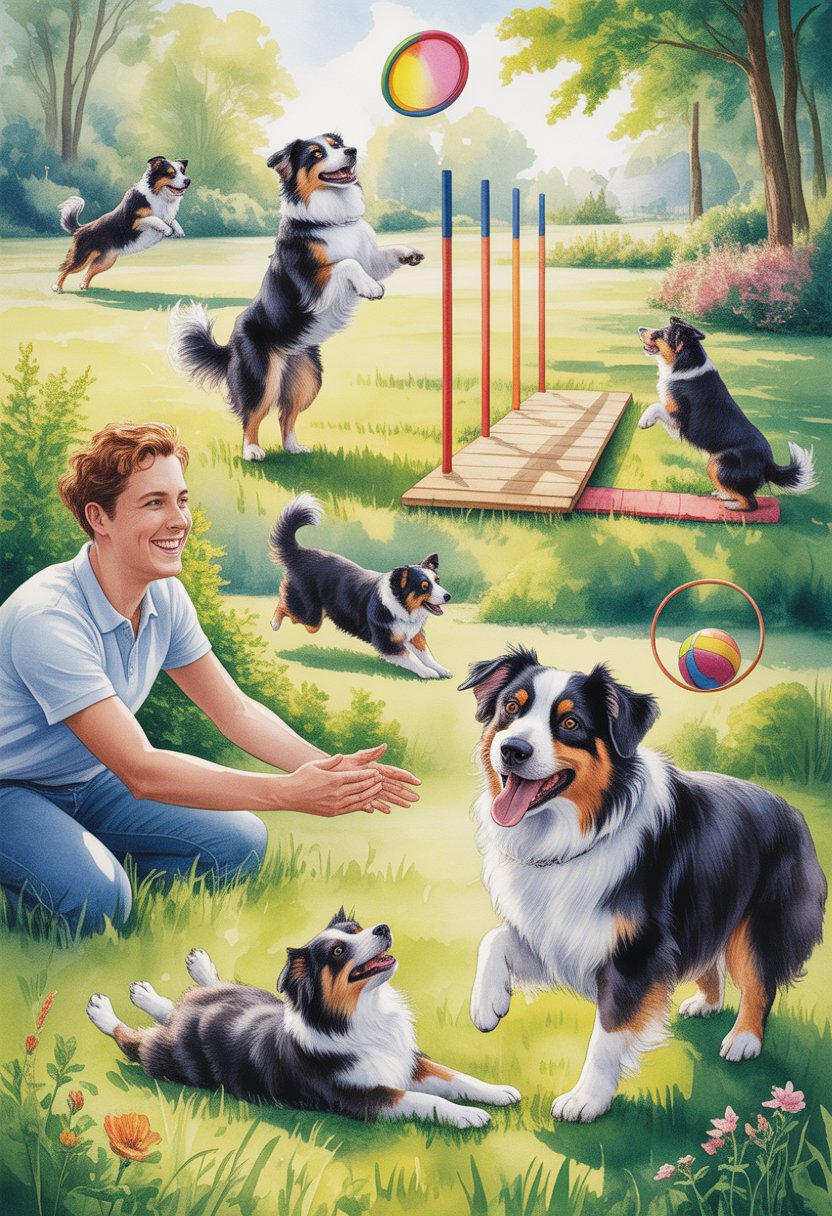
Trick training gives Australian Shepherds a fun way to use their sharp minds. These dogs enjoy learning and often pick up new skills quickly when the training stays positive and engaging.
Simple tricks like “shake,” “spin,” or “roll over” provide mental exercise and build confidence. Once they master the basics, they can move on to more advanced challenges.
Clicker training works well for Aussies because it marks the exact moment they do something right. Pairing the click with a small treat helps them understand and stay motivated.
Short sessions of 10 to 15 minutes keep their attention without overwhelming them. Frequent breaks and encouragement make the process enjoyable for both the dog and the owner.
Trick training also strengthens the bond between an Australian Shepherd and their family. The shared activity creates trust and gives the dog a sense of purpose.
Why Australian Shepherds Thrive With Training
Australian Shepherds are intelligent, energetic dogs. They need both mental and physical outlets.
Training gives them structure. It keeps their minds sharp and helps them use their energy in positive ways.
Mental Stimulation and Emotional Wellbeing
Australian Shepherds love solving problems. If they don’t get enough challenges, they can get restless or even frustrated.
Training sessions give them puzzles and tasks that keep their brains working. Herding used to do that for them, but now training fills that role.
They really thrive on positive reinforcement—treats, toys, or just a happy voice. This feedback builds trust and helps them feel more confident.
When Aussies succeed at something, they know it. That little win makes them more excited to learn next time.
Simple things like learning a new trick, practicing agility, or playing with puzzle toys keep their minds busy. Even five or ten minutes of real focus each day can lift their mood.
Mental activity also reduces stress. Dogs that use their brains regularly seem calmer and less likely to get anxious.
Preventing Unwanted Behaviors
If Australian Shepherds don’t get direction, their energy can turn into destructive habits. Chewing up furniture, digging, or barking too much are all signs they’re bored.
Training gives them clear jobs and expectations, which helps prevent these problems.
Consistency really matters. If rules change or you don’t reinforce commands, they’ll get confused and might act out.
Clear boundaries make life easier for everyone. Aussies learn what’s okay and what’s not, and that stability helps a lot.
Structured activities like herding games, obedience drills, or trick training give them a real sense of purpose.
Instead of inventing their own entertainment, they can channel energy into stuff you actually want them to do.
Tips for Making Training Sessions Fun
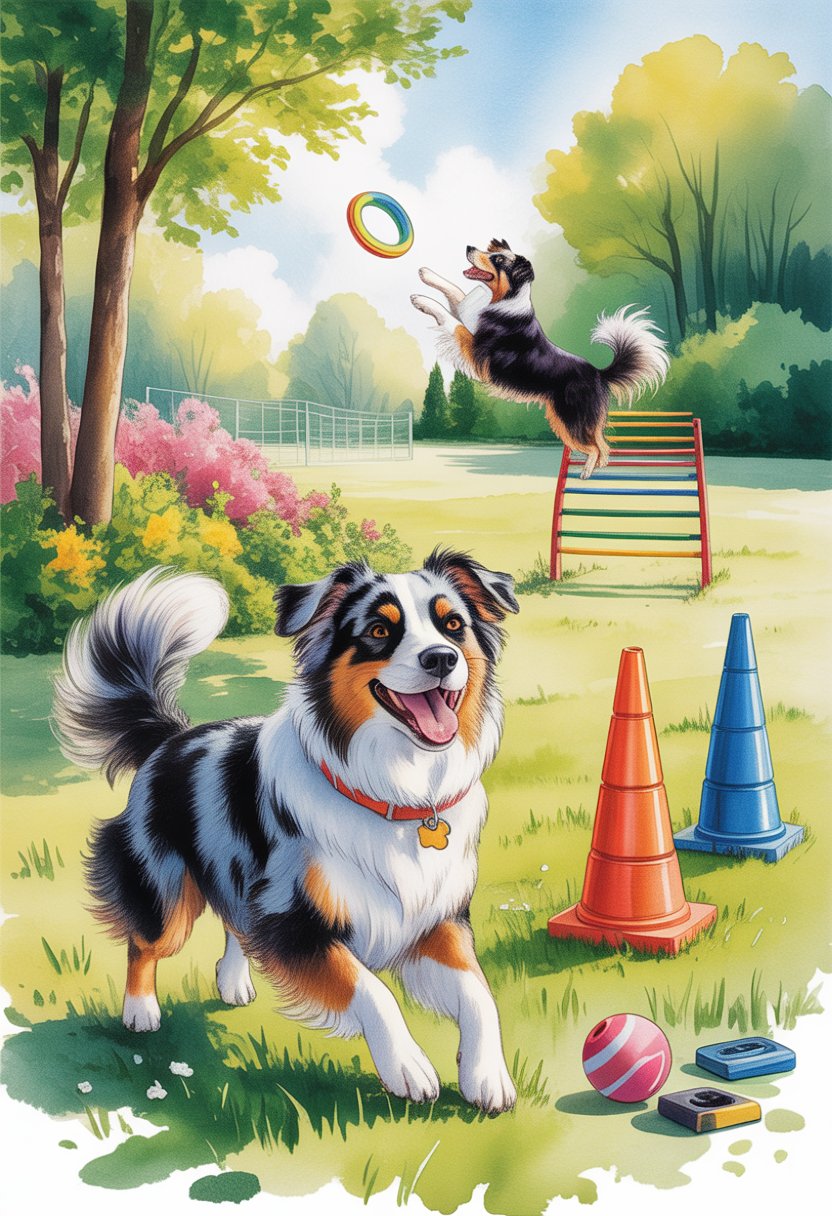
Australian Shepherds pick things up faster when training feels like a game. Keeping sessions upbeat and organized keeps them focused and less likely to get bored.
Incorporating Play and Rewards
Aussies love positive reinforcement. Give treats, toys, or a happy word right after they get it right, and they’ll remember the lesson.
Rewards should be small and frequent—just enough to keep them motivated without distracting them.
Mix training into play. Ask for a sit before tossing a ball, or a down before a round of tug-of-war. That way, learning sneaks into the fun.
It also teaches patience and self-control, even when things get exciting.
Short bursts work best. Five or ten minutes of training, then a play break, beats one long session any day.
Try rotating between obedience, tricks, and agility to keep things interesting.
Quick ideas for fun rewards:
- A game of fetch after a correct command
- A favorite chew toy during breaks
- Extra praise and petting for calm behavior
Setting a Consistent Routine
Consistency really helps Australian Shepherds figure out what you want from them. Training at the same times each day creates a rhythm they can count on.
Dogs pick things up faster when they know what’s coming. Honestly, it just makes life easier for everyone.
It’s important to keep commands and cues the same. If one person says come and someone else says here, the dog’s bound to get confused.
Everyone in the house should stick to the same words and reward system. Otherwise, you’ll probably end up with a puzzled pup.
A structured plan stops you from overdoing it. Too much repetition? That frustrates both you and your dog.
A balanced schedule keeps things interesting. Here’s a simple routine you might try:
| Time of Day | Activity | Duration |
|---|---|---|
| Morning | Obedience practice | 10 minutes |
| Afternoon | Agility or outdoor play | 15 minutes |
| Evening | Trick training | 5 minutes |
Mixing structure with a little variety makes training way more enjoyable—for you and your dog.


